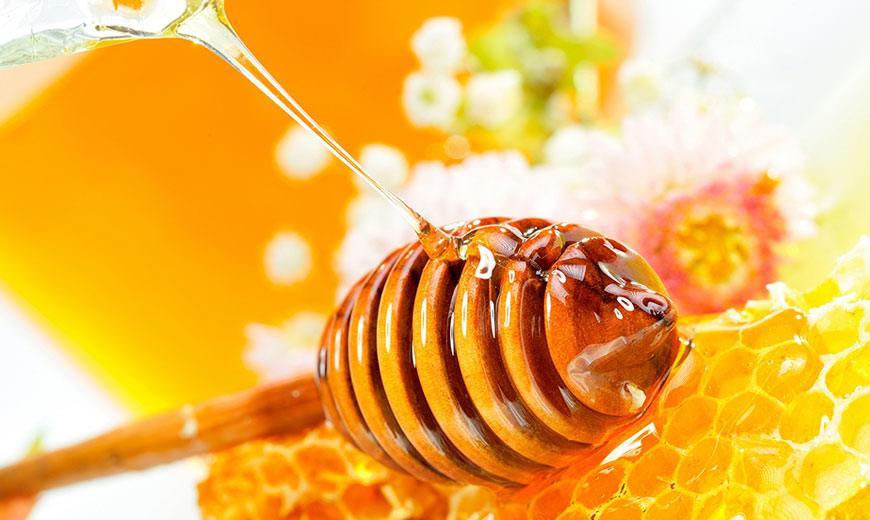
Erfahren Sie als erste
Melden Sie sich noch heute für den CBDFULL Newsletter an.

Ein Wundheilmittel mit langer Tradition
Die heilende Eigenschaft von Honig beruht auf der Tatsache, dass er antibakteriell, antimykotisch und antiviral wirkt, einen feuchten Wundzustand aufrechterhält und durch seine hohe Viskosität eine Schutzbarriere gegen Infektionen bildet. Honig wird schon seit dem Altertum in vielen Kulturen als Arznei gegen zahlreiche Hauterkrankungen sowie zur Wundheilung geschätzt. Das älteste Schriftstück, in dem Honig erwähnt wird, ist eine ca. 4000 Jahre alte Tontafel der Sumerer mit Rezepten für Salben und Medikamente[1].
Honig ist in der Lage Antibiotikaresistenzen aufzuheben.
Honig wird zunehmend bei der Behandlung von Hauterkrankungen und infizierter Wunden eingesetzt, bei denen herkömmliche pharmazeutische Produkte versagen.[2]
Dank seinem breiten Spektrum an Phytonziden hemmt Honig das Wachstum von krankheitserregenden Mikroorganismen bzw. zerstört nachweislich alle bisher getesteten Mikroorganismen, auch gefürchtete antibiotikaresistente Bakterien wie z.B. Staphylococcus aureus in chronischen Wunden oder den Hefepilz Candida albicans.[3] Nach der Anwendung von Honig können Infektionen mit zuvor antibiotikaresistenten Bakterien wirksam mit Antibiotika behandelt werden.[4] [5]
Forschungen:
Honig als Wundverband
unterstützt Heilungsprozesse und stimuliert körpereigene Immunantworten[6] [7], zerstört Krankheitserreger auf natürliche Weise und ist sehr effektiv bei der Behandlung von Akne, Schnittwunden, Verbrennungen, Blutergüssen und Wunden mit Infektionsgefahr [8]. Honig beseitigt die Infektion, Debridement, unterdrückt Entzündungen, minimiert Narben, stimuliert die Angiogenese, Gewebe-Granulation, Epithel-Wachstum[9] [10] und lindert Schmerzen[11]. Ärzte benutzten Honig zur Behandlung von Geschwüren, Verbrennungen, Fisteln und Furunkeln[12], sowie fast alle Arten von Wunden wie Abrieb, Abszess, Amputation, Dekubitus, Verbrennungen, Schüttelfrost, geplatzte Bauchwunde, rissige Brustwarzen, Fisteln, diabetische, bösartige, Lepra-, traumatische, zervikale Krampf- und Sichelzellen-Geschwüre, sowie septische Wunden.[13] [14] Studien bei Fournier-Gangrän bestätigen rasche Besserung mit vermindertem Ödem und Ausfluss, schnellerer Regeneration und geringerer oder keiner Narbenbildung, effektivem Wunddebridement und Abnahme der Mortalität [15]
Honig bei Pilzinfektionen
Honig hat eine antimykotische Wirkung gegen alle gängigen Dermatophyten[16] [17], hemmt Toxinproduktion[18], bakterielle Infektionen[19] und ist wirksam bei Behandlung von seborrhoischer Dermatitis und Schuppen [20].
Antivirale Wirkung von Honig
Honig ist im Vergleich zu Aciclovir sicher und wirksam gegen Herpes labialis, Herpes Genitalis [21] und Rötelnvirus [22]
Honig in der Augenheilkunde
Honig wird weltweit zur Behandlung verschiedener Erkrankungen des Auges und der umgebenden Strukturen wie Hornhautverletzungen, Bindehautentzündung, Blepharitis, Keratitis, Verätzungen, thermischer und chemischer Verbrennungen eingesetzt [23] [24].
Die Anwendung von Honig bei infektiöser Konjunktivitis reduzierte die Rötung, Schwellung und Eiterausfluss bis zur kompletten Auslöschung des Krankheitserregers aus dem Körper. [25] [26]
[1] Geschichte der Wundbehandlung mit Honig, Deutscher Ärzteverlag ZFA Z Allg. Med 2015, 91(4)
[2] Mandal MD, Mandal S. Honey: its medicinal property and antibacterial activity. Asian Pac J Trop Biomed. 2011;1(2):154-160. doi:10.1016/S2221-1691(11)60016-6
[PMC]
[3] Cooper R. Honey in wound care: antibacterial properties. GMS Krankenhhyg Interdiszip. 2007;2(2):Doc51. Published 2007 Dec 28
[PMC]
[4] McLoone P, Oluwadun A, Warnock M, Fyfe L. Honey: A Therapeutic Agent for Disorders of the Skin. Cent Asian J Glob Health. 2016;5 (1):241. Published 2016 Aug 4.
[PMC]
[5] McLoone P, Warnock M, Fyfe L. Honey: A realistic antimicrobial for disorders of the skin. J Microbiol Immunol Infect. 2016;49(2):161-167.
[Science Direct]
[6] Medhi B, Puri A, Upadhyay S, Kaman L. Topical application of honey in the treatment of wound healing: a meta analysis. JK Sci . 2008;10:166–169.
[jkscience.org]
[7] Tonks AJ, Cooper RA, Jones KP, Blair S, Parton J, Tonks A. Honey stimulates inflammatory cytokine production from monocytes. Cytokine. 2003;21:242–247.
[PubMed]
[8] Dr. S. Mladenov, The Preservative Effect of Honey, Pchelarstvo Magazine, issue 12, 1967
[honeypedia]
[9] Comparison of the antibacterial activity of honey from different provenance against bacteria usually isolated from skin wounds. Basualdo C, Sgroy V, Finola MS, Marioli JM Vet Microbiol. 2007 Oct 6; 124(3-4):375-81.
[PubMed]
[10] Medhi B, Puri A, Upadhyay S, Kaman L. Topical application of honey in the treatment of wound healing: a meta analysis. JK Sci . 2008;10:166–169.
[jkscience]
[11] Topical application of honey in treatment of burns. Subrahmanyam M Br J Surg. 1991 Apr; 78(4):497-8.
[PubMed]
[12] Honey-a remedy rediscovered and its therapeutic utility. Bansal V, Medhi B, Pandhi P Kathmandu Univ Med J (KUMJ). 2005 Jul-Sep; 3(3):305-9.
[PubMed]
[13] Clinical observations on the wound healing properties of honey. Efem SE Br J Surg. 1988 Jul; 75(7):679-81.
[PubMed]
[14] Mixture of honey, beeswax and olive oil inhibits growth of Staphylococcus aureus and Candida albicans. Al-Waili NS Arch Med Res. 2005 Jan-Feb; 36(1):10-3.
[PubMed]
[15] Predisposing factors and treatment outcome in Fournier's gangrene. Analysis of 28 cases. Gürdal M, Yücebas E, Tekin A, Beysel M, Aslan R, Sengör F Urol Int. 2003; 70(4):286-90.
[PubMed]
[16] Sampath Kumar KP, Bhowmik D, Chiranjib , Biswajit , Chandira MR. Medicinal uses and health benefits of Honey: An overview. J Chem Pharm Res . 2010;2:385–395.
[jocpr]
[17] . Brady NF, Molan PC, Harfoot CG. The sensitivity of dermatophytes to the antimicrobial activity of manuka honey and other honey. J Pharm Sci. 1997;2:1–3.
[Wiley Online Library]
[18] Effect of honey on antibody production against thymus-dependent and thymus-independent antigens in primary and secondary immune responses. Al-Waili NS, Haq A J Med Food. 2004 Winter; 7(4):491-4.
[PubMed]
[19] Honey--a remedy rediscovered and its therapeutic utility. Bansal V, Medhi B, Pandhi P Kathmandu Univ Med J (KUMJ). 2005 Jul-Sep; 3(3):305-9.
[PubMed]
[20] Therapeutic and prophylactic effects of crude honey on chronic seborrheic dermatitis and dandruff. Al-Waili NS Eur J Med Res. 2001 Jul 30; 6(7):306-8.
[PubMed]
[21] Investigating the antimicrobial activity of natural honey and its effects on the pathogenic bacterial infections of surgical wounds and conjunctiva. Al-Waili NS J Med Food. 2004 Summer; 7(2):210-22.
[PubMed]
[22] Effect of honey on antibody production against thymus-dependent and thymus-independent antigens in primary and secondary immune responses. Al-Waili NS, Haq AJ Med Food. 2004 Winter; 7(4):491-4.
[PubMed]
[23] Therapeutic uses of honey and honeybee larvae in central Burkina Faso. Meda A, Lamien CE, Millogo J, Romito M, Nacoulma OG J Ethnopharmacol. 2004 Nov; 95(1):103-7.
[PubMed]
[24] Traditional medicine in oman: its role in ophthalmology. Shenoy R, Bialasiewicz A, Khandekar R, Al Barwani B, Al Belushi H Middle East Afr J Ophthalmol. 2009 Apr; 16(2):92-6.
[PubMed]